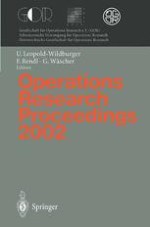2003 | OriginalPaper | Chapter
Optimal Sorting Machine Allocation in the Postal Distribution Network
Author : Jaroslav Janáček
Published in: Operations Research Proceedings 2002
Publisher: Springer Berlin Heidelberg
Included in: Professional Book Archive
Activate our intelligent search to find suitable subject content or patents.
Select sections of text to find matching patents with Artificial Intelligence. powered by
Select sections of text to find additional relevant content using AI-assisted search. powered by
The postal distribution system constitutes many-to-many distribution system with several transshipments [1], [3]. At the beginning, consignments are transported by vehicles from post offices to transit centers. Another fleet continuous the transport from transit centers. This one finishes at so-called sorting center, which serve a given cluster of the transit centers. Rough sorting of the consignments coming from the individual transit centers of the cluster is done in the sorting center to separate the consignments according to destination sorting centers and each class is divided according to the destination transit centers. Having completed the rough sorting, each bulk of consignments is transported to the destination-sorting center. Fine sorting is performed there to separate the consignments in accordance to destination post offices. The fine sorting is completed after all bulks have been sorted. Then the sorted consignments are loaded on vehicles and transported to destination transit centers to be there up to the time, when distribution to the destination post offices starts. It can be noticed that the earliest time of consignment bulk departure from its original transit center results from given times of departures from the transit centers. The similar situation occurs at the opposite end of the transport chain. The arrival time of a bulk at the destination transit center is fixed for distribution fleet to be able to complete its work in time. It follows that the time of bulk departure from destination sorting center is given as well.
